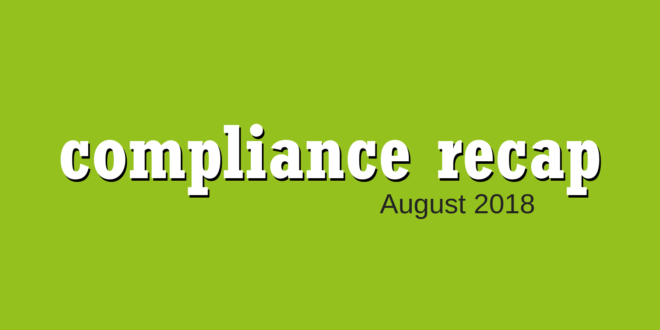Compliance Recap | August 2018
 August was a relatively quiet month in the employee benefits world.
August was a relatively quiet month in the employee benefits world.
The Internal Revenue Service (IRS), the Department of Health and Human Services (HHS), and the Department of Labor (DOL) published a final rule that amends the definition of short-term, limited-duration insurance. HHS also released a fact sheet on the final rule. To provide guidance on association health plans, the DOL posted a fact sheet and the IRS posted a new Q&A for employers. The IRS also released a memo regarding tax payment of a prior year’s fringe benefits.
IRS, HHS, and DOL Issue Final Rule on Short-Term, Limited-Duration Insurance
On August 3, 2018, the Internal Revenue Service, the Department of Health and Human Services (HHS), and the Department of Labor (collectively, the Departments) published a final rule that amends the definition of short-term, limited-duration insurance. HHS also released a fact sheet on the final rule.
According to the Departments, the final rule will provide consumers with more affordable options for health coverage because they may buy short-term, limited-duration insurance policies that are less than 12 months in length and may be renewed for up to 36 months.
The final rule will apply to insurance policies sold on or after October 2, 2018.
Read more about the final rule.
DOL and IRS Release Additional Information on Association Health Plans
On August 20, 2018, the Department of Labor (DOL) posted the Association Health Plans ERISA Compliance Assistance fact sheet.
On August 20, 2018, the IRS added a new Q&A 18 to its Questions and Answers on Employer Shared Responsibility Provisions Under the Affordable Care Act. Q&A 18 confirms that:
- An employer that is not an applicable large employer (ALE) under the employer shared responsibility provisions does not become an ALE due to participation in an AHP.
- An employer that is an ALE under the employer shared responsibility provisions continues to be an ALE subject to the employer shared responsibility provisions regardless of its participation in an AHP.
- The only circumstance when multiple employers are treated as a single employer for determining whether the employer is an ALE is if the employers have a certain level of common or related ownership.
Read more about the association health plan final rule.
IRS Releases Memo Regarding Tax Payment of Prior Year’s Fringe Benefits
The Internal Revenue Services (IRS) Office of Chief Counsel released Project Manager Technical Advice Memorandum 2018-015. The fact situation involves an employer that failed to include $10,000 in fringe benefits in an employee’s taxable wages for 2016. The employer will be satisfying its obligations by paying the federal income tax withholding and FICA taxes in 2018.
The IRS states that an employer’s payment of taxes that should have been withheld in a prior year does not create additional wages to the employee for the prior year.
Further, if the employer deducts the employee FICA tax from other remuneration paid to the employee (or otherwise collects the amount from the employee), the payment of employee FICA tax by the employer is not additional compensation to the employee in 2018.
However, if the employer does not seek repayment of the employee FICA tax from the employee, the employer’s payment of employee FICA tax in 2018 (without collecting the amount from the employee) is additional wages to the employee when paid in 2018 and is subject to employment taxes.
The Question of the Month
- Under the ACA, if an employer’s size grows, when does the employer need to offer coverage and report on coverage offered?
- If the employer employs an average of at least 50 full-time or full-time equivalent employees during calendar year 2018, then it would make offers of coverage in 2019, and report in 2020 on its offers of coverage made in 2019.
The applicable large employer determination is a three-year cycle. For example, an employer’s size, calculated at the conclusion of 2018 determines its obligations for 2019, which it reports on in 2020.
If 2018 is the first time that a company is an applicable large employer, then the company will have until April 1, 2019, to offer coverage. If the company has individuals who are currently full-time employees and the company offers a group health plan, then the company must offer coverage to those full-time employees on January 1, 2019.

